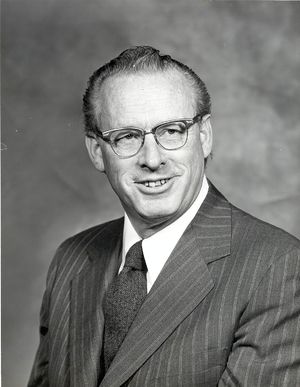George B. Litchford
- Birthdate
- 1918
- Birthplace
- Long Beach, CA, USA
- Death date
- 2008/02/28
- Fields of study
- Aviation
- Awards
- IEEE Lamme Medal
Biography
George B. Litchford was an American inventor who spent his career developing the airline collision warning system now ubiquitous on most aircraft.
Born in Long Beach, California, in 1918, Lichtford grew up in Portland, Oregon, where he graduated from Reed College in 1941 after completing his thesis on an aviation-electronic project. Joining the Research Laboratories of the Sperry Corporation at Garden City, N.Y., in 1941, he worked on Radar and Microwave Landing Systems. After World War II he invented, developed, and tested his integrated Air Traffic Control System. Designing both ground and airborne electronic elements, he added pictorial pilot and controller displays. Portions of this system are in worldwide use and his work won him numerous awards, including the Pioneer Award (1974) and the Lamme Medal (1981) of the IEEE. He served on committees of the Department of Defense (ROB), and the first meetings of the United Nations' International Civil Aviation Organization (ICAO). He joined Airborne Instruments lab in 1951 where he headed the Aviation Systems Department. Litchford served on the White House "Curtis Committee" as the head of the Aviation Facilities Planning Group and as a member of the Systems Engineering Team. This "Curtis" plan resulted in restructuring the CAA into the FAA and closer civil-military cooperation in solving the nation's air navigation and traffic control problems. He also pioneered the only operational microwave landing system, SPN-41 or "C-SCAN," now in Navy use with ship and shore installations providing landing guidance to thousands of C-SCAN-equipped aircraft. Various derivatives of this landing system are used by other nations, the Marines, the Army, and the NASA Space Shuttle. Lichtford also contributed to many improvements in internationally standardized aviation systems of Secondary Radar, VHF Landing, and Omniranges.
In 1965, Litchford started his own company providing consulting and design services in the field of Aviation Systems. The list of his clients included many major airframe and avionic companies, as well as government agencies, universities, and professional groups in the aviation field. In association with NASA, he helped establish a graduate program at MIT, Princeton, and Ohio University in Aviation System Design. He served on numerous committees of the Government and professional societies and held nearly 100 patents at the time of his death. He was a Fellow of the IEEE and the American Institute of Aeronautics and Astronautics (AIAA). In 1978 he received the Wright Brothers Medal (AIAA) and delivered that year's Wright Brothers Lecture.
After living most of his life in Northport, Long Island, Lichtford died in Albany on February 28, 2008.
